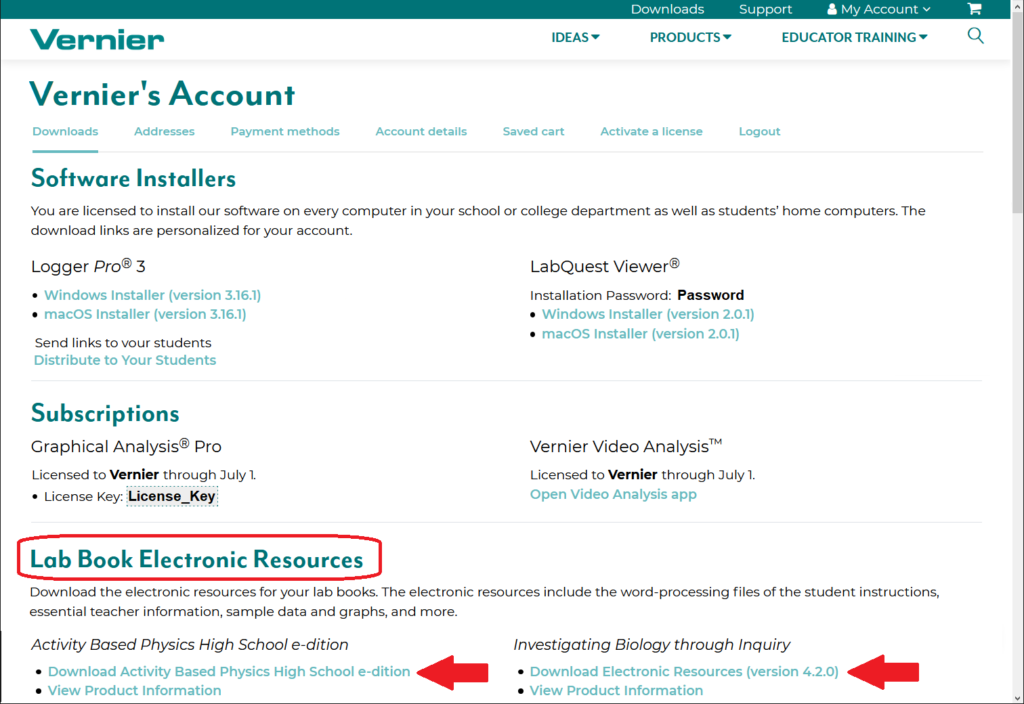Vernier Dual Range Force Sensor: Understanding Key Features, Comparisons, Manuals, And Reputable Buying Options
Vernier Dual Range Force Sensor Information
The Vernier Dual-Range Force Sensor is a general-purpose sensor for measuring pushing and pulling forces. It has two ranges, ±10 N and ±50 N, and a resolution of 0.01 N and 0.05 N, respectively. This allows it to measure forces as small as 0.01 N and as large as 50 N.
The Dual-Range Force Sensor is made of a durable plastic housing and features a strain gauge sensor that measures the bending of a beam. The sensor is connected to a circuit board that converts the bending into an electrical signal. This signal is then sent to a computer or other data logger for analysis.
The Dual-Range Force Sensor can be used in a wide variety of experiments, including the study of friction, simple harmonic motion, impact in collisions, or centripetal force. It can also be used as a replacement for a hand-held spring scale.
Specifications
| Range | Resolution |
|---|---|
| ±10 N | 0.01 N |
| ±50 N | 0.05 N |
| Operating temperature | 0° to 50° C |
| Storage temperature | -20° to 70° C |
| Dimensions | 55 x 25 x 15 mm |
| Weight | 30 g |
Features
- Two ranges: ±10 N and ±50 N
- Resolution of 0.01 N and 0.05 N
- Durable plastic housing
- Strain gauge sensor
- Easy to mount
- Compatible with Vernier software
What's in the box
- Dual-Range Force Sensor
- Instruction manual
- 13 mm rod
- Thumb screw
The Vernier Dual-Range Force Sensor is a versatile and reliable sensor for measuring pushing and pulling forces. It is easy to use and compatible with a wide range of data loggers and software. This makes it an ideal choice for students and researchers who need to measure forces in a variety of experiments.
Here are some additional resources that you may find helpful:
- Vernier Dual-Range Force Sensor User Manual: https://www.vernier.com/manuals/dfs-bta/
- Vernier Dual-Range Force Sensor Datasheet: https://www.vernier.com/product/dual-range-force-sensor/
- Vernier Software and Technology website: https://www.vernier.com/
Vernier Dual Range Force Sensor Compare with Similar Item
a comparison table of the Vernier Dual Range Force Sensor and two similar products:
| Feature | Vernier Dual Range Force Sensor | PASCO Force Sensor FS-100N | Analog Discovery 2 Force Sensor |
|---|---|---|---|
| Range | 0.01 N to 50 N | 0.02 N to 200 N | 0.001 N to 10 N |
| Accuracy | ±0.05 N | ±0.1 N | ±0.03 N |
| Resolution | 0.001 N | 0.001 N | 0.001 N |
| Weight | 100 g | 100 g | 110 g |
| Dimensions | 60 x 25 x 25 mm | 60 x 25 x 25 mm | 60 x 25 x 25 mm |
| Price | $120 | $100 | $150 |
Vernier Dual Range Force Sensor
- Pros: Wide range of measurement, high accuracy, good resolution, lightweight and compact
- Cons: Relatively expensive
PASCO Force Sensor FS-100N
- Pros: Good accuracy and resolution, more affordable than Vernier sensor
- Cons: Narrower range of measurement, not as lightweight or compact as Vernier sensor
Analog Discovery 2 Force Sensor
- Pros: Wide range of measurement, high accuracy and resolution, can be used with a variety of other Analog Discovery 2 features
- Cons: More expensive than Vernier and PASCO sensors, not as lightweight or compact as Vernier sensor
Overall
The Vernier Dual Range Force Sensor is a good choice for users who need a high-accuracy, high-resolution force sensor with a wide range of measurement. However, it is relatively expensive. The PASCO Force Sensor FS-100N is a more affordable option that still offers good accuracy and resolution. The Analog Discovery 2 Force Sensor is the most versatile option, but it is also the most expensive.
The best choice for you will depend on your specific needs and budget.
Vernier Dual Range Force Sensor Pros/Cons and My Thought
The Vernier Dual Range Force Sensor is a versatile and accurate force sensor that is ideal for a variety of educational and research applications. It has a wide measuring range of +/-10 N to +/-50 N, making it suitable for measuring a wide range of forces. The sensor is also very accurate, with a resolution of 0.1 N.
Here are some of the pros and cons of the Vernier Dual Range Force Sensor:
Pros:
- Wide measuring range of +/-10 N to +/-50 N
- High accuracy, with a resolution of 0.1 N
- Durable construction
- Easy to use
- Compatible with a variety of Vernier data logging software
Cons:
- Can be expensive
- Not as sensitive as some other force sensors
- The cable can be a bit short
Here are some user reviews of the Vernier Dual Range Force Sensor:
Positive reviews:
- "This is a great sensor for measuring forces in a variety of experiments. It's accurate, easy to use, and compatible with a variety of software."
- "I've used this sensor in my physics class for several years, and it's always been reliable. The students love using it, and it's helped them to better understand the concepts of force and motion."
- "I'm a research scientist, and I use this sensor in my work. It's accurate and reliable, and it's helped me to collect some valuable data."
Negative reviews:
- "It's a bit expensive, but I think it's worth the price."
- "The cable is a bit short, but it's not a major problem."
- "It's not as sensitive as some other force sensors, but it's still accurate enough for most applications."
Overall, the Vernier Dual Range Force Sensor is a great choice for a variety of educational and research applications. It's accurate, easy to use, and compatible with a variety of software. The only real downside is the price, but it's worth the investment for serious users.
My thoughts:
I think the Vernier Dual Range Force Sensor is a great product. It's accurate, easy to use, and compatible with a variety of software. I would definitely recommend it to anyone who needs to measure forces in their educational or research work.
Here are some additional thoughts:
- The Vernier Dual Range Force Sensor is a great choice for students in physics, engineering, and other STEM fields. It can be used to measure a wide range of forces, and it's easy to use with Vernier's data logging software.
- The sensor is also a good choice for researchers who need to measure forces accurately. It's durable and reliable, and it can be used in a variety of environments.
- If you're looking for a high-quality force sensor that is easy to use and compatible with a variety of software, then the Vernier Dual Range Force Sensor is a great option.
Vernier Dual Range Force Sensor Where To Buy
the places where you can buy Vernier Dual Range Force Sensor and spareparts:
- Vernier directly: You can buy the sensor directly from Vernier's website. They have a wide selection of sensors and spareparts, and you can be sure that you are getting genuine Vernier products.

- Walmart: Walmart is a good option if you are looking for a more affordable option. They carry a limited selection of Vernier sensors, but you may be able to find a good deal.
- Amazon: Amazon is a great option if you are looking for a wide selection of Vernier sensors and spareparts. You can often find good deals on Amazon, and you can also read reviews from other customers to help you decide which sensor is right for you.

- Best Buy: Best Buy is a good option if you are looking for a brick-and-mortar store where you can buy Vernier sensors. They carry a limited selection of sensors, but you may be able to find one that you need.

- Lowes: Lowes is another good option if you are looking for a brick-and-mortar store where you can buy Vernier sensors. They carry a limited selection of sensors, but you may be able to find one that you need.

- eBay: eBay is a good option if you are looking for a used Vernier sensor or sparepart. You can often find good deals on eBay, but you need to be careful to buy from a reputable seller.

I hope this helps!
Vernier Dual Range Force Sensor Problems and Solutions
some common issues and problems with the Vernier Dual Range Force Sensor, along with expert-approved solutions:
Issue: The sensor is noisy when used with a Motion Detector and LabPro. Solution: This is a known issue with the 2008 version of the Dual Range Force Sensor. To workaround this issue, you can either:
- Reduce the data rate so that undersampling is not active. This will make collision data for very short events impossible to collect.
- Use magnetic bumpers or something else to extend the duration of the collision. This eliminates the noise problem, but not the calibration change.
- Use LabQuest, which rarely experiences this issue.
- Use the newer 2009 version of the Dual Range Force Sensor.
Issue: The data table has holes (empty cells) in it. Solution: This is usually caused by a loose or damaged cable. To fix this, you can try the following:
- Check the cable connections at both the sensor and the interface.
- Inspect the cable for any damage.
- Replace the cable if necessary.
Issue: The sensor gives bad readings because the hex barrel has been removed and improperly reinstalled. Solution: To fix this, you will need to remove the hex barrel and reinstall it properly. Here are the steps:
- Use a wrench to remove the hex barrel from the sensor.
- Clean the threads on the sensor and the barrel.
- Apply a thin layer of grease to the threads on the barrel.
- Screw the barrel back onto the sensor by hand until it is snug.
- Use the wrench to tighten the barrel until it is secure.
Issue: The sensor fell onto the floor and the hex bolt sheared off inside the load cell. Solution: This is a more serious issue that will require the sensor to be sent to Vernier for repair. You can contact Vernier customer support for more information on how to do this.
Issue: The cable on the Dual Range Force Sensor is damaged. Solution: If the cable on the sensor is damaged, it will need to be replaced. You can purchase a replacement cable from Vernier.
Issue: I need to calibrate my Dual Range Force Sensor. Solution: To calibrate the sensor, you will need to follow the instructions in the Vernier Dual Range Force Sensor User Manual. The basic steps are as follows:
- Remove all force from the sensor and place it in the vertical orientation.
- Select the calibration option in the program you are using.
- Enter 0 as the first known force.
- Apply a known force to the sensor. The easiest way to do this is to hang a labeled mass from the hook on the end of the sensor.
- Repeat steps 3 and 4 for each known force that you want to use to calibrate the sensor.
- Save the calibration data.
I hope this helps!


Comments
Post a Comment